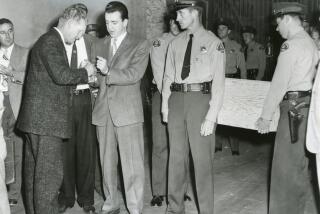The birth of one form of death penalty
Executioner’s Current
Thomas Edison, George Westinghouse, and the Invention of the Electric Chair
Richard Moran
Alfred A. Knopf: 276 pp., $25
*
“Executioner’s Current” is a timely book. The United States is in one of its recurring reexaminations of the death penalty. Illinois has put a moratorium on executions as it inquires into the fairness and justice of death as a punishment for crime. The extensive new use of human DNA as an indicator of guilt or innocence has raised questions about the awful finality of killing convicted criminals.
Now most states have replaced electrocution with lethal injection as the preferred method of killing criminals. Richard Moran’s well-sustained thesis is that “every so-called advance in the means of execution has been in response to a rise in opposition to the death penalty.”
So it has been, he argues, with the adoption of lethal injection. So it was, he demonstrates, when more than 100 years ago electrocution widely and rapidly replaced hanging.
Moran, a professor of sociology at Mount Holyoke College and author of “Knowing Right From Wrong: The Insanity Defense of Daniel McNaughtan,” lucidly tells the fascinating story of the arrival of electrocution on the American scene. Its most powerful proponent was none other than the premier American inventor Thomas Edison. Edison’s motives were not only as he claimed, to replace hanging with something more humane, but also to discredit his archrival in the generation and distribution of electricity, George Westinghouse.
By the late 1880s Edison had already invented the phonograph and the lightbulb and was deeply into the distribution of electricity for the illumination of cities. His preferred method was by direct current. Westinghouse, though, was demonstrating that alternating current was easier and cheaper, and Westinghouse’s corporation was overtaking Edison’s in public favor.
Meanwhile, the New York Legislature in 1886 established a commission under Elbridge T. Gerry, grandson of a signer of the Declaration of Independence, to inquire into the best method of execution. Hanging was falling into disrepute, both because it was too often botched -- some victims choked slowly to death, others’ heads were ripped off -- and because of the recent memory of very public hangings conducted in full view of an often boisterous or drunken crowd.
As the Gerry Commission met, public resistance to the death penalty was rising; the New York Legislature very nearly passed a prohibition. Edison, though in principle opposed to the death penalty, mounted a campaign in favor of electrocution -- but only with Westinghouse’s alternating current. Moran conclusively shows that Edison hoped to discredit alternating current -- by associating it in the public mind with death -- and advance his own direct current.
The commission supported electrocution and the Legislature approved. Now New York needed only a human subject. The lot fell to William Kemmler, an illiterate and habitually drunken Buffalo huckster who with a hatchet killed his faithless girlfriend.
Determined to stop the project, which would use secondhand Westinghouse dynamos, Westinghouse made sure Kemmler had powerful New York lawyers. The case went all the way to the U.S. Supreme Court, which in the end upheld a lower court’s decision that while death by electrocution was unusual, it was not cruel, a finding that stands to this day.
Kemmler, Moran writes, was the only person in the drama of his death on Aug. 6, 1890, who was not “diminished” by the ordeal; “indeed, he seemed elevated by it.” During his 18 months on death row, he learned to read and sign his name, he studied the Bible with the warden’s wife, gave up tobacco “and made peace with his Maker.”
Kemmler believed his death would be peaceful and painless. It wasn’t. After the first jolt, he began to breathe again. Another longer jolt left him obviously dead, but charred and smoking.
About 4,300 convicted criminals were killed by electrocution in the United States in the 20th century, according to Moran. He thinks it likely no more will be, now that lethal injection is more generally accepted. But what about it?
No method of execution, Moran writes, “can ever be considered humane.” Our ambivalent feelings about the death penalty have led us to put it further and further away from our sight as we console ourselves that it is somehow not painful, not violent, when really it always is.
More to Read
Sign up for our Book Club newsletter
Get the latest news, events and more from the Los Angeles Times Book Club, and help us get L.A. reading and talking.
You may occasionally receive promotional content from the Los Angeles Times.






